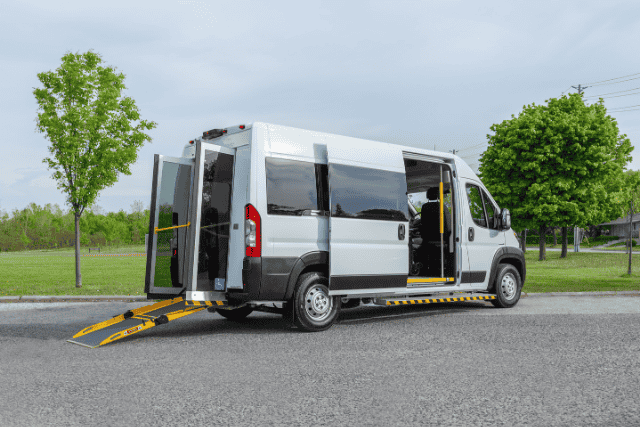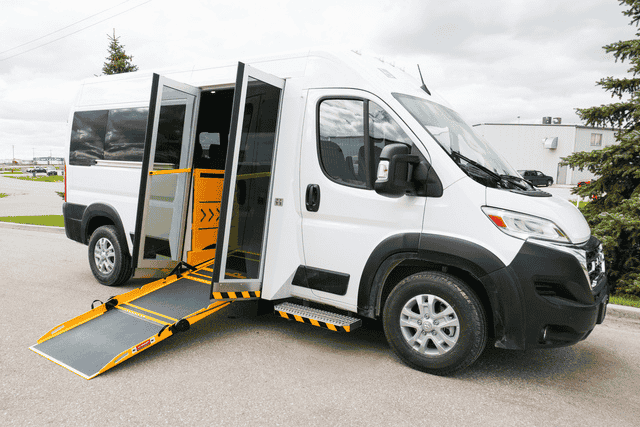Is your organization feeling stuck trying to decide between a rear entry or side entry wheelchair van? You’re not alone. It’s a big decision, and you want to make sure you’re getting the best option for your passengers, your budget, and your organization.
The last thing you want is to end up with a wheelchair van that makes things harder instead of easier. Trying to figure out which type of van is the right fit can be stressful, especially when it’s such an important investment. But don’t worry—we’ve got your back. This article is here to guide you through it.
At AVAN Mobility, we’ve been helping organizations like yours for over 10 years, providing wheelchair accessible and mobile medical vans that break down barriers to healthcare and transportation.
We’ve worked with organizations like CalOptima to ensure people can get the medical care they desperately need. While we take pride in being experts, we know we’re not the only ones in the industry. So, we’re going to give you all the facts without any bias so that you can make the best choice for your needs.
By the end of this article, you’ll know five important things to think about when choosing between rear entry wheelchair vans and side entry wheelchair vans. Let’s make this decision a little easier for you!
5 considerations with rear vs. side entry wheelchair vans
When your organization invests in a wheelchair van, it pays to get it right.
In the next few sections, we’ll look at five considerations when buying a rear or side-entry wheelchair van.
1. Wheelchair size and weight
One of the first things you’ll want to consider when choosing between a rear entry and side entry wheelchair van is the size and weight of your passengers’ wheelchairs. If any of your passengers have large or heavier wheelchairs, this could play a big role in your decision.
Why it matters:
If the wheelchair is on the heavier side, having passengers enter through the back of the van might be the easier option. When using a rear entry wheelchair van, there’s typically more space for the person to roll straight into the vehicle. Plus, there’s no need to turn the wheelchair around once it’s inside, which can save your staff or caregivers some hassle.
For example, imagine trying to maneuver a large, motorized wheelchair in a tight side-entry space. It’s tricky, right? That’s one of the reasons many transit organizations in the U.S. that transport heavier wheelchairs lean toward rear entry wheelchair vans. It allows for a smoother entry and exit and reduces the need for extra adjustments once inside.
Is rear or side entry better for this?
If you regularly transport heavier or oversized wheelchairs, a rear entry wheelchair van is your best bet. It makes the loading process easier for everyone involved and can save time. However, if wheelchair size isn’t a concern, a side entry wheelchair van could still be an option worth considering.
2. Parking and accessibility

Another important factor when considering between a rear entry and side entry wheelchair van is how much parking space you’ll have and need. When you’re navigating busy U.S. parking lots or pulling into narrow driveways, space can be a real issue when trying to load and unload passengers safely.
Why it matters:
When using a side entry wheelchair van, you’ll need extra room beside the vehicle to fully extend the wheelchair van ramp. That means if you’re in a tight parking spot or a crowded area, this could get tough. You’ll need to make sure there’s enough space for the wheelchair to roll out without hitting other cars or objects.
On the other hand, a rear entry wheelchair van only needs enough space behind the vehicle to deploy the van wheelchair ramp. This can make things much easier in places like:
- Narrow driveways
- Garages
- Tight, busy parking lots, like those at hospitals or shopping centers.
Is rear or side entry better for this?
If your wheelchair van will be operating in urban areas where there are narrow or crowded spaces, as we mentioned, a rear entry wheelchair van is the way to go. It gives you more flexibility and less stress when parking. However, if you mostly park in open areas with plenty of space, a side entry van could work just as well.
3. Number of passengers and daily use

The third consideration is how many passengers you’ll be transporting on a typical day. This can help determine whether a side entry or rear entry wheelchair van will be the best fit for your needs.
Why it matters:
A side entry wheelchair van allows for smoother access for multiple passengers. If you’re running a service like community transit, where you have several pickups and drop-offs throughout the day, a side entry van makes getting in and out faster. Passengers can easily board from the sidewalk, and there’s no need to reposition the van or deal with busy parking lots.
Side entry vans also tend to have more seating options. They can fit more ambulatory passengers, which is ideal for:
- School transportation programs
- Day programs for seniors or adults with disabilities
- Shuttle services for medical appointments or group outings
On the other hand, a rear entry van may be better suited if you’re focusing on transporting a few people or individuals who use large or heavy wheelchairs. In a rear entry van, there’s a clear pathway through the back without needing to worry about seating arrangements.
Is rear or side entry better for this?
If you’re moving a larger group of people throughout the day, especially in a transit or shuttle situation, a side entry wheelchair van will be more efficient. It allows for quicker, easier access. But if your focus is on individual transportation or fewer passengers at a time, a rear entry wheelchair van might work just as well.
4. Passenger mobility and comfort

Another thing to think about when choosing a rear or side entry wheelchair accessible van is the comfort level of your passengers. If your organization transports people who use walkers, canes, or other mobility aids, you’ll want to consider how they feel about using a van wheelchair ramp or lift.
Why it matters:
Some passengers may feel uneasy or unsafe when using a lift, especially since it raises them into the air. For those nervous about heights or stability, this could be a source of stress every time they board.
A side entry wheelchair van with a ramp might be a better option, especially a heavy-duty, transit-grade one with integrated handles like what we use at AVAN Mobility. Ramps tend to feel safer and more stable since passengers don’t have to be lifted. A wheelchair ramp for the van side door also allows them to board directly from the sidewalk, which can help them feel more secure.
On the flip side, if your passengers are comfortable getting in and out on a driveway or less busy area, a rear entry ramp could work just fine.
Key points to consider:
- Side entry ramps offer easy, street-level access and are often more reassuring for passengers with limited mobility.
- Rear entry ramps are a good alternative if you’re loading passengers in quieter, low-traffic areas like a private parking lot or driveway.
Is rear or side entry better for this?
If your passengers feel uneasy with lifts or prefer direct, easy access from the sidewalk, a side entry wheelchair van with a ramp is likely the better choice. However, if loading and unloading in less busy areas isn’t a concern, a rear entry van can still be a solid option.
5. Future needs and flexibility
The last consideration to keep in mind when choosing between a rear entry or side entry wheelchair van is your organization’s future needs. While a standard wheelchair van may meet your current requirements, it’s important to consider how your transportation demands might grow or change in the coming years.
Why it matters:
A side entry van offers a bit more flexibility if you anticipate adding more passengers or expanding your services. With its spacious interior and easier access for multiple passengers, it can accommodate growth without needing a new vehicle. This makes side entry vans a solid long-term investment if your organization is planning for expansion.
In contrast, a rear entry van works well for more specialized or focused services, like transporting bulky, heavy wheelchairs.
In addition, some organizations even consider adding something like stretcher transportation to their programs down the road. Choosing a vehicle like the P4 3-in-1 that can do many things under the same roof can save your organization spending extra money on three different vehicles.
Key points to consider:
- Side entry vans are ideal if you expect growth in services or passenger count.
- Rear entry vans are better suited for more predictable transportation needs.
Is rear or side entry better for this?
If you expect your organization to grow or expand services, a side entry van might offer the flexibility you’ll need in the future. However, if your operations are stable and you don’t see significant changes ahead, a rear entry van may be the route to take.
Need help deciding between rear vs. side entry wheelchair vans?

You came to this article because choosing between rear entry or side entry wheelchair vans can feel overwhelming. It’s a big decision, and the last thing you want is to make the wrong choice for your organization’s needs.
After reading this article, you now know the five key factors to consider when deciding between rear and side entry wheelchair vans.
At AVAN Mobility, we believe that every vehicle we build is an opportunity to make a difference. We create solutions that help break down barriers to healthcare and transportation all across North America. For example, we partnered with the Community Clinic of Southwest Missouri to build a Mobile Clinic Van, enabling them to bring healthcare services directly to people without sufficient healthcare insurance.
Our passion for innovation and customer care is what sets us apart. If you have any questions, click the button below to talk to one of our mobility experts.
If you’re not ready to talk to someone yet, feel free to explore some of our other resources to learn more.
Start by checking out our article on the 11 steps to choosing a wheelchair van. This resource will give you some guidance and clarity on what to do next.





